Hatay Archaeology Museum
The Hatay Archaeology Museum (Turkish: Hatay Arkeoloji Müzesi) is the archaeology museum of Antakya, Turkey. It is known for its extensive collection of Roman and Byzantine Era mosaics.[1] The museum is located in Antakya, the main city of Hatay. Construction of the museum started in 1934 on the recommendation of the French archaeologist and antiquities inspector Claude M. Prost.[2] It was completed in 1938 and came under Turkish control in 1939 following Hatay's unification with Turkey. The museum was opened to the public in 1948 and re-opened in 1975 following renovation and expansion.[2]

But: Contrary to the information above the museum is now in another building, at Antakya Reyhanlı Yolu No:117. The coordinates above are wrong. The new museum houses many more objects, and is even more important as a treasure-trove of mosaics, and other ancient objects. This message may be followed by more extensive edits to this article. For the time being: ignore the old information one still can find on many spots on the web (information regarding the objects shown is still correct).
Collection
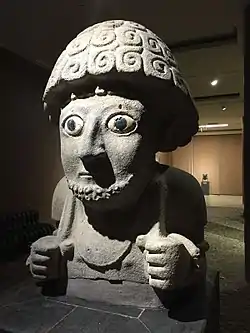
Hatay has a rich collection of mosaics dating back to the Hellenistic and to the Roman era in the 2nd and 3rd centuries.[1][3] They have been found in the ancient cities of Daphne, Seleucia Pieria (Samandağ), Antioch and Tarsus.[4] The most famous figures among those depicted by the mosaics are the drunken Dionysos, Orpheus, Dancers, Ariadne Abandoned from Defne (Yakto). Column capitals, a sacrificial altar, a cult image, a bas-relief, a fresco and statues date from the Hittites to Roman periods. They were found by excavations in barrows in the plain of Amik. The works in the museum are arranged according to where they were found. Excavations have been carried out at barrows, tells and ruins such as Guneyde, Dehep, Catalhoyuk, Tainat, Al Mina, Ac-ana, Defne-Harbiye and so on. The collection also includes objects from Antakya and its surrounding regions.
The museum's collection also includes items that reflect the art and culture of the region, from the Paleolithic Age through the present day. The objects are displayed in wall niches. Against the other walls of the room are cases that display a rare coin collection arranged chronologically. The museum's garden includes Roman period sarcophagi, building stones and water jars. In 1999 German archeologist Jutta Meischner received permission to study and publicize Greek and Roman sculptures from the Hatay Archeology Museum.[5] In early 2012, a section of the museum's collection was digitized as part of an effort to increase museum attendance.[6]
Restoration
Restoration taking place in 2014-2015 has been suspended after several major works were botched and local media brought it to the attention of the public.[7]
References
- Burch, Jonathan (2012-05-18). "48 hours in Hatay, Turkey". Reuters. Retrieved 2012-09-10.
- "Hatay Archaeology Museum". goturkey.com. Archived from the original on 2012-10-11. Retrieved 2012-09-10.
- "Mosaic City: Hatay". Skylife. August 2011. Retrieved 2012-09-10.
- https://www.lonelyplanet.com/turkey/attractions/hatay-archaeology-museum/a/poi-sig/1006677/360857
- Meischner, J.: Die Skulpturen des Hatay Museums von Antakya, Jahrbuch des Deutschen Archäologischen Museums, Band 118, 2003, 285-384. Verlag Walter de Gruyter, Berlin.
- "Antakya's mosaics join the virtual world Antakya's mosaics join the virtual world". TurkishPress.com. 2012-02-01. Retrieved 25 February 2015.
- "Ancient mosaics seriously damaged during restoration in Turkey's Hatay".
| Wikimedia Commons has media related to Antakya Archaeological Museum. |
External links
- Hatay Archeology Museum website, Ancient useless link
- Hatay Museum at Ministry of Culture website, outdated
- Not the museum site itself, but decent information in 2020
- Over 670 pictures of exhibits
Gallery
 Antakya Archaeological Museum Actor mosaic
Antakya Archaeological Museum Actor mosaic Antakya Archaeological Museum Boat of the Psyches mosaic
Antakya Archaeological Museum Boat of the Psyches mosaic Antakya Archaeological Museum Dionysos and Ariadne mosaic
Antakya Archaeological Museum Dionysos and Ariadne mosaic Antakya Archaeological Museum Dionysos and Ariadne mosaic
Antakya Archaeological Museum Dionysos and Ariadne mosaic Antakya Archaeological Museum Dionysos and Ariadne mosaic
Antakya Archaeological Museum Dionysos and Ariadne mosaic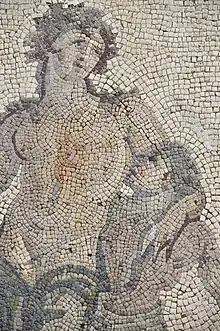 Antakya Archaeological Museum Dionysus mosaic
Antakya Archaeological Museum Dionysus mosaic Antakya Archaeological Museum Ephygenia in Aulis mosaic
Antakya Archaeological Museum Ephygenia in Aulis mosaic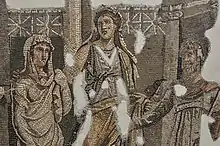 Antakya Archaeological Museum Ephygenia in Aulis mosaic
Antakya Archaeological Museum Ephygenia in Aulis mosaic Antakya Archaeological Museum Eros and Psyche mosaic
Antakya Archaeological Museum Eros and Psyche mosaic Antakya Archaeological Museum Ganymede mosaic
Antakya Archaeological Museum Ganymede mosaic Antakya Archaeological Museum Ge and Karpoi mosaic
Antakya Archaeological Museum Ge and Karpoi mosaic Antakya Archaeological Museum Herakles mosaic
Antakya Archaeological Museum Herakles mosaic Antakya Archaeological Museum Orpheus mosaic
Antakya Archaeological Museum Orpheus mosaic Antakya Archaeological Museum Sundial mosaic
Antakya Archaeological Museum Sundial mosaic Antakya Archaeological Museum Thetis and Oceanus mosaic
Antakya Archaeological Museum Thetis and Oceanus mosaic Antakya Archaeological Museum Thiasos mosaic
Antakya Archaeological Museum Thiasos mosaic Antakya Archaeological Museum Buffet mosaic
Antakya Archaeological Museum Buffet mosaic Antakya Archaeological Museum Buffet mosaic
Antakya Archaeological Museum Buffet mosaic Antakya Archaeological Museum Buffet mosaic
Antakya Archaeological Museum Buffet mosaic Antakya Archaeological Museum Detail of some mosaic
Antakya Archaeological Museum Detail of some mosaic Antakya Archaeological Museum Detail of some mosaic
Antakya Archaeological Museum Detail of some mosaic Antakya Archaeological Museum Four seasons mosaic
Antakya Archaeological Museum Four seasons mosaic Antakya Archaeological Museum Four seasons mosaic
Antakya Archaeological Museum Four seasons mosaic Antakya Archaeological Museum Four seasons mosaic
Antakya Archaeological Museum Four seasons mosaic Antakya Archaeological Museum Four seasons mosaic
Antakya Archaeological Museum Four seasons mosaic Antakya Archaeological Museum Yakto mosaic
Antakya Archaeological Museum Yakto mosaic Antakya Archaeological Museum Yakto mosaic
Antakya Archaeological Museum Yakto mosaic Antakya Archaeological Museum Yakto mosaic
Antakya Archaeological Museum Yakto mosaic Antakya Archaeological Museum Yakto mosaic
Antakya Archaeological Museum Yakto mosaic Antakya Archaeological Museum Yakto mosaic
Antakya Archaeological Museum Yakto mosaic Antakya Archaeological Museum Geometric mosaic
Antakya Archaeological Museum Geometric mosaic Antakya Archaeological Museum Geometric mosaic
Antakya Archaeological Museum Geometric mosaic Antakya Archaeological Museum Geometric mosaic
Antakya Archaeological Museum Geometric mosaic Antakya Archaeological Museum Geometric mosaic
Antakya Archaeological Museum Geometric mosaic Antakya Archaeological Museum Geometric mosaic
Antakya Archaeological Museum Geometric mosaic Antakya Archaeological Museum Geometric mosaic
Antakya Archaeological Museum Geometric mosaic Antakya Archaeological Museum Geometric mosaic
Antakya Archaeological Museum Geometric mosaic Antakya Archaeological Museum Stove
Antakya Archaeological Museum Stove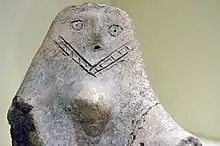 Antakya Archaeological Museum Cooking support
Antakya Archaeological Museum Cooking support Antakya Archaeological Museum Assyrian style lions
Antakya Archaeological Museum Assyrian style lions Antakya Archaeological Museum Kings head
Antakya Archaeological Museum Kings head Antakya Archaeological Museum Hittite temple entrance
Antakya Archaeological Museum Hittite temple entrance Antakya Archaeological Museum Late Hittite stele
Antakya Archaeological Museum Late Hittite stele Antakya Archaeological Museum Emperor Trebonianus Gallus
Antakya Archaeological Museum Emperor Trebonianus Gallus Antakya Archaeological Museum Sleeping traveller
Antakya Archaeological Museum Sleeping traveller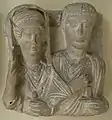 Antakya Archaeological Museum Stele
Antakya Archaeological Museum Stele Antakya Archaeological Museum Byzantine coin
Antakya Archaeological Museum Byzantine coin
